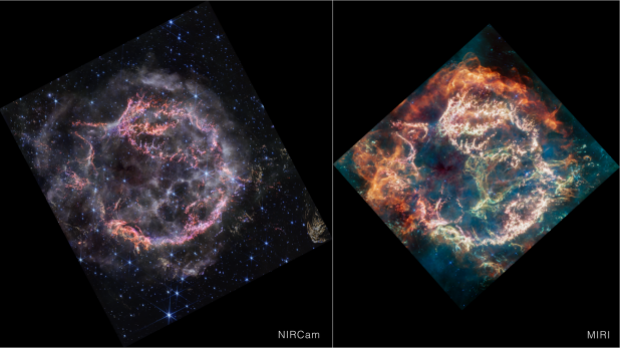In April, the James Webb Space Telescope’s (JWST) Mid-Infrared Instrument (MIRI) snapped an eye-catching picture of the supernova remnant Cassiopeia A (abbreviated Cas A), located 11,000 light-years away in the constellation Cassiopeia the Queen. The image was colored green and red to represent different wavelengths of infrared light. Now, a second look at the region is giving more insight into its cosmic composition.
Using JWST’s Near-Infrared Camera (NIRCam), researchers have mapped out several elements in the region, which appear as purple, pink, and white flecks scattered about the new image. These detailed marks make up the inner shell of Cas A, which is composed of sulfur, oxygen, argon, and neon from the star, whose explosion reached us 340 years ago.
According to a news release from the European Space Agency (ESA), the outer edge of the main shell in the NIRCam image has a ghostly look to it in contrast to the MIRI view, where it shines brightly (colored orange). This is because the dust there is too cool to be seen in near-infrared light, but is picked up better in the mid-infrared light viewed by MIRI.
Another noticeable change from the original image it the missing the swirls of green gas near the center, which had been nicknamed the Green Monster. The unknown blob was picked up in mid-infrared light but NIRCam did not see it. However, both cameras saw circular “holes” that now hint at an explanation: According to the release, the holes are ringed by ionized gas, generated as debris from the explosion pushes through and sculpts the gas.

Cassiopeia A was imaged at near-infrared wavelengths by NIRCam at left, and longer mid-infrared wavelengths by MIRI at right. Credit: NASA, ESA, CSA, STScI, D. Milisavljevic (Purdue University), T. Temim (Princeton University), I. De Looze (University of Gent)
NIRCam also made a stunning discovery: a feature researchers are calling Baby Cas A, near the bottom right. This smudge of white scratch marks was so named “because it appears like an offspring of the main supernova,” according to the ESA release.
This baby, which sits 170 light-years behind the larger supernova remnant, is called a light echo. It appears bright as energetic photons blasted away during the initial explosion are reaching this blob of dust, warming it so it glows in the infrared. It is one of several light echoes in the image.
Other supernovae that will be investigated by JWST include the recent SN 2023ixf and the older SN 1987A, among others . Studying the dust in these regions can help researchers determine the reason for these explosions and how they will continue to evolve over time.